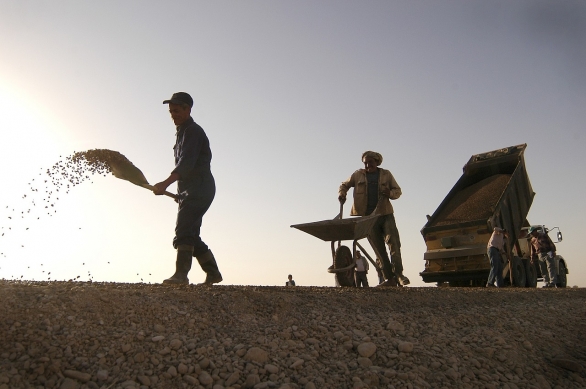
Metal Buildings
Driveway Options from the Road to Your Building: Cement, Gravel, Asphalt
For many customers, their new VersaTube garage, shop, or barn is going to be built on a new site, away from any existing driveways. No problem if you’re just pulling a riding lawnmower into a shed. However, if you’re building a garage for your vehicle, a workshop, a barn, or another structure that will attract some traffic, don’t overlook the driveway when you’re planning for your build! Sure, a packed bare-dirt drive can work, but for many regions, the rainy season will turn your driveway into a mud-fest. Instead, we recommend one of these three materials for your driveway:
Cement
You may prefer hiring someone to build your driveway, but if you’re a do-it-yourself kind of guy, you could DIY your cement driveway. The process can be broken down into these basic steps:
• Check local regulations and obtain a permit if needed. Your city or homeowners association may have restrictions about the places you can build.
• Draw out the plans. Map out the size and shape of your drive. Don’t forget to take into account what width you need. A single-vehicle requires a width of 10-12 feet.
• Calculate how much cement you need. Figure the cubic area (length x width x depth). To calculate it into cubic yards, which is usually how cement is sold, divide that number by 27. Once you start pouring your drive, you need to finish it in one go, so purchase extra cement in case of errors and spills.
• Build forms. To make the process easier, consider breaking your driveway down into smaller sections. For example, 4' x 4’ squares instead of a few large sections.
• Compact the soil and add clay, sand, or gravel if needed to firm it up.
• Stake out the shape and then install the forms.
• Use fill material as needed to level the depth. Your driveway needs to be at least 4” thick. To make sure you don’t have any dips, divots, and uneven spots, grade the driveway. A simple way to grade is to tie a string across the top of your forms and measure down to the soil. As you find areas that are not even, you can remove the problem or add crushed rock or gravel to make it even.
• Pour the cement and flatten each slab.
• If you didn’t break your forms into small sections, add 1” deep cuts across the driveway, called contraction joints, every 4’ or so. This will give it a room to contract as it dries so you don’t end up with cracks.
• Spray it with curing compound and let it cure for at least a week before being used.
Pouring your own driveway involves several steps, but it’s a straightforward process and doing it yourself will stretch your budget.
Gravel
Inexpensive, low-maintenance, and easy-to-DIY, gravel has a lot to recommend as a choice for your driveway. Once completed, you may need to clean up the edges or rake everything back into place occasionally, but that’s the only maintenance required. The steps to DIY a gravel drive are fairly simple:
• Stake out your driveway.
• Clear away grass and topsoil.
• Calculate how many cubic yards of gravel you need using the method above.
• Order the gravel. Typically, a gravel driveway has 3 layers about 4” thick each. The bottom layer is larger stones, about 6-inches in size. They’ll need to be compacted into the soil for a strong foundation before adding the next layer. The middle layer consists of stones 2 to 3 inches in size. The top layer is the stones are the small stones we all think of as gravel.
• Level the path.
• Add each layer of gravel and spread it. Most gravel delivery trucks will spread gravel so be sure to ask.
Simple, classic, and built to last, a gravel driveway is a good choice for many VersaTube owners!
Asphalt
Asphalt is a good alternative to cement. It doesn’t have quite the same lifespan, but it’s less expensive and eco-friendly. Unlike cement, asphalt can be 100% recycled, making it a choice you can feel good about. While the installation process is somewhat similar to the one described for cement, it’s more complicated, thanks to the heat of poured asphalt and the need for major compacting. Some DIYers may want to tackle this project, but most will want to hire a contractor for installing an asphalt driveway.
Whatever driveway you choose, it’s a good idea to design it with a slight slope to help water drain away. Now that you’ve got a plan in place for your driveway, do you have other questions about installing your VersaTube structure? Check out our Learning Center! It’s packed with helpful information for all customers, whether you plan to DIY your build or hire a contractor.













